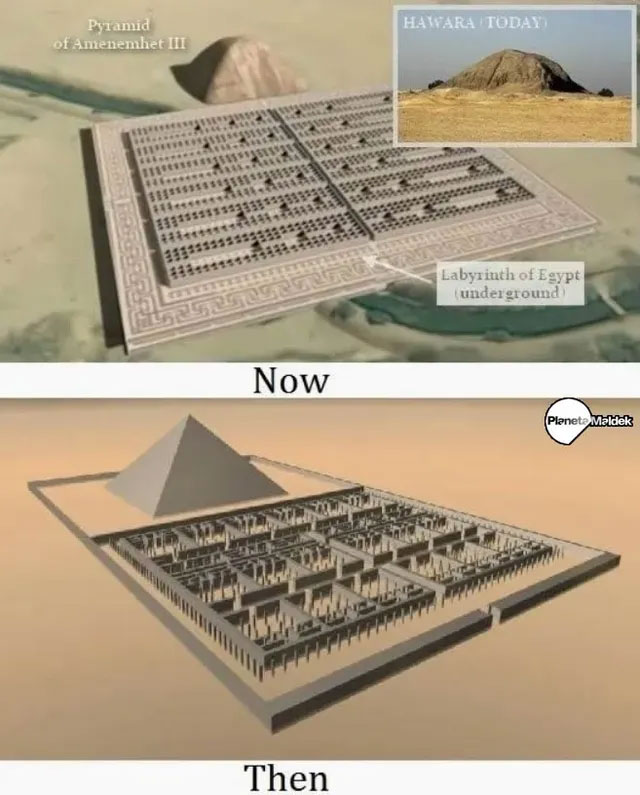Mysterious discovery: Ancient underground labyrinth temple in Egypt!
Beneath the pyramids of Egypt lies a lost underworld with catacombs, excavation chambers, and cave tunnels that have remained unexplored for hundreds of years.
They are alluded to in ancient Arabic texts and legends, but remained undiscovered until recent times. And it wasn't until now that we discovered the first visible clues and investigated them. But what exactly does this underground "kingdom" tell us about the pyramids, their relationship to the stars, and the mythical origins of Egyptian civilization?
According to the text of Herodotus I in the 4th century BC: labyrinth The ancient Greek historian Herodotus once wrote: "They (12 kings) were determined to join together to build a memorial to themselves. their solution; their solution led to the execution of a maze, located near Lake Moiris and almost opposite the so-called Crocodile city. descriptive language.
If we gathered all the buildings and all the great works produced by the Hellenes (another name for the Greeks, referring to the Greeks), there would be a loss in labor as well as a loss in labor power. costs for this labyrinth, despite the fact that both the temple in Ephesos and in Samos are valuable structures".
"When entering the sacred surroundings, one finds a temple surrounded by columns, 40 on each side. The temple has a roof of a single stone slab, carved and decorated with paintings. It contains memorabilia of each king's homeland as well as of the temples and sacrifices performed therein, all of which are skillfully crafted to create paintings that are the ultimate beauty".

The labyrinth (as it was called by some in the distant past) is believed to be an extraordinary underground complex that may hold the key to mankind's history. It is said that there we can find detailed information about historically unknown civilizations, great empires and rulers that lived on this planet before history. begin.
One of the first attempts to study the labyrinth seriously was in 1842, with a group sent to Egypt by the Prussian king Friedrich Wilhelm IV. The team, led by archaeologist Richard Lepsius, believe that the pyramid Herodotus was referring to was the pyramid of Amenemhat III located in the Hawara region of Faium and that Crocodile was an ancient city located in the valley. Faiyum Oasis Valley.
Accordingly, this labyrinth is said to be a legend passed down through generations. However, this view has changed since Egyptologist Flinders Petrie discovered its "foundation". These findings have led experts to theorize that the labyrinth was destroyed during the reign of Ptolemy II and used to build the nearby city of Shedyt in honor of his wife Arsinoe.
As described, the underground temple consists of more than 3000 rooms filled with amazing paintings and hieroglyphs, this mysterious underground complex is located less than 100 km from Cairo at Hawara.
Here, in 2008, a team of researchers from Belgium and Egypt came to investigate the mysterious underground complex, hoping to find and solve the mystery behind this mysterious complex. The Belgian-Egyptian expedition was able to confirm the presence of an underground temple not far from the Pyramid of Amenemhat III.

The expedition was named Mataha (Mataha means labyrinth in Arabic), and it confirmed the presence of an underground temple just south of the pyramid of Amenemhat III.
In fact, this ancient labyrinth has been mentioned by many ancient writers, who claim that this is a truly monumental size work and this may be the key to prove its existence. of a lost civilization before the ancient cultures associated with the region today. Some even say that it is one of the keys to explaining the true history of mankind.
Since the 17th century, the German scholar Athanasius Kircher has relied on the description of the labyrinth by the Greek historian Herodotus, to draw the image of the mysterious labyrinth. According to Kircher, the Egyptian labyrinth is located underground right next to the pyramid of Amenemhat IIII in Havara, 100km from Cairo.
The results of the Mataha Expedition were published in the fall 2008 scientific journal of the NRIAG, and the results were shared at the Ghent University public conference. Soon after, Dr Zahi Hawass, Secretary General of the Supreme Council of Antiquities (Egypt), called for a halt to the publication of the results due to the bans of Egypt's National Security. The researchers waited patiently for Dr. Hawass to publish the results.
However that did not happen. And the information that we can gather about this labyrinth is extremely meager, perhaps over time, it will gradually be forgotten for most of us.
- New discovery about the ancient temple Chavín de Huántar 3000 years in Peru
- Discovered the 3400-year-old temple of the ancient Egyptians
- Repair sewer, dig ... whole mysterious temple 2,200 years old
- Mysterious labyrinth under Rome
- Discovered 7,000-year-old mysterious city underground Egypt
- Discovered a 3,000-year-old tomb in Egypt
- The mystery behind the strange, permanent landmarks is not allowed to open
- Discovered the 4,500 year old sphinx in Egypt
- Discovered 3,000-year-old megalithic temple in Peru
- Decode the mysterious cemetery about 3400 years
- Discover mysterious underground structures in Russia
- Egypt discovered ancient tombs from the time of Pharaoh Ramses II
 Discovered an ancient centipede fossil 99 million years old
Discovered an ancient centipede fossil 99 million years old Discovered bat-like dinosaurs in China
Discovered bat-like dinosaurs in China Discovered a 200-year-old bronze cannon of the coast
Discovered a 200-year-old bronze cannon of the coast Discover 305 million-year-old spider fossils
Discover 305 million-year-old spider fossils